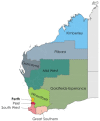Exploring factors impacting early childhood health among Aboriginal and Torres Strait Islander families and communities: protocol for a population-based cohort study using data linkage (the 'Defying the Odds' study)
- PMID: 29599395
- PMCID: PMC5875609
- DOI: 10.1136/bmjopen-2017-021236
Exploring factors impacting early childhood health among Aboriginal and Torres Strait Islander families and communities: protocol for a population-based cohort study using data linkage (the 'Defying the Odds' study)
Abstract
Introduction: Empirical evidence on family and community risk and protective factors influencing the comparatively high rates of potentially preventable hospitalisations and deaths among Aboriginal and Torres Strait Islander infants and children is limited. As is evidence on geographical variation in these risks. The 'Defying the Odds' study aims to explore the impact of perinatal outcomes, maternal social and health outcomes and level of culturally secure service availability on the health outcomes of Western Australian (WA) Aboriginal infants and children aged 0-5 years.
Methods and analysis: The study combines a retrospective cohort study that uses state-wide linked health and administrative data from 12 data sources for multiple generations within Aboriginal families in WA, with specifically collected survey data from health and social services supporting Aboriginal families in regions of WA. Data sources include perinatal/birth registration, hospital, emergency department, mental health services, drug and alcohol service use, mortality, infectious disease notifications, and child protection and family services. Multilevel regression models will be used to examine the intensity of admissions and presentations, mortality, intensity of long stays and morbidity-free survival (no admissions) for Aboriginal children born in WA in 2000-2013. Relationships between maternal (and grand-maternal) health and social factors and child health outcomes will be quantified. Community-level variation in outcomes for Aboriginal children and factors contributing to this variation will be examined, including the availability of culturally secure services. Online surveys were sent to staff members at relevant services to explore the scope, reach and cultural security of services available to support Aboriginal families across selected regions of WA.
Ethics and dissemination: Ethics approvals have been granted for the study. Interpretation and dissemination are guided by the study team's Aboriginal leadership and reference groups. Dissemination will be through direct feedback and reports to health services in the study and via scientific publications and policy recommendations.
Keywords: aboriginal health; community child health; hospitalisations; mortality; perinatology.
© Article author(s) (or their employer(s) unless otherwise stated in the text of the article) 2018. All rights reserved. No commercial use is permitted unless otherwise expressly granted.
Conflict of interest statement
Competing interests: None declared.
Figures



Similar articles
-
Trends in mental health related contacts among mothers of Aboriginal children in Western Australia (1990-2013): a linked data population-based cohort study of over 40 000 children.BMJ Open. 2019 Jul 2;9(7):e027733. doi: 10.1136/bmjopen-2018-027733. BMJ Open. 2019. PMID: 31266837 Free PMC article.
-
What factors contribute to positive early childhood health and development in Australian Aboriginal children? Protocol for a population-based cohort study using linked administrative data (The Seeding Success Study).BMJ Open. 2015 May 18;5(5):e007898. doi: 10.1136/bmjopen-2015-007898. BMJ Open. 2015. PMID: 25986640 Free PMC article.
-
Cohort profile: Understanding the influence of early life environments and health and social service system contacts over time and across generations through the Western Australian Aboriginal Child Health Survey (WAACHS) Linked Data Study.BMJ Open. 2024 Oct 2;14(10):e087522. doi: 10.1136/bmjopen-2024-087522. BMJ Open. 2024. PMID: 39357983 Free PMC article.
-
The participation of Aboriginal and Torres Strait Islander parents in Australian trials of parenting programs for improving children's health: a scoping review.Med J Aust. 2024 Apr 1;220(6):331-335. doi: 10.5694/mja2.52198. Epub 2024 Jan 8. Med J Aust. 2024. PMID: 38186285
-
Achieving cultural safety for Australia's First Peoples: a review of the Australian Health Practitioner Regulation Agency-registered health practitioners' Codes of Conduct and Codes of Ethics.Aust Health Rev. 2021 Aug;45(4):398-406. doi: 10.1071/AH20215. Aust Health Rev. 2021. PMID: 33844959 Review.
Cited by
-
"Cultural Security Is an On-Going Journey…" Exploring Views from Staff Members on the Quality and Cultural Security of Services for Aboriginal Families in Western Australia.Int J Environ Res Public Health. 2020 Nov 16;17(22):8480. doi: 10.3390/ijerph17228480. Int J Environ Res Public Health. 2020. PMID: 33207696 Free PMC article.
-
Identifying young Aboriginal and Torres Strait Islander children in linked administrative data: A comparison of methods.Int J Popul Data Sci. 2020 Mar 16;5(1):1100. doi: 10.23889/ijpds.v5i1.1100. Int J Popul Data Sci. 2020. PMID: 32935045 Free PMC article.
-
Maternal asthma in Australian indigenous women and perinatal outcomes: A whole population-linked study.Int J Gynaecol Obstet. 2023 Feb;160(2):653-660. doi: 10.1002/ijgo.14363. Epub 2022 Aug 8. Int J Gynaecol Obstet. 2023. PMID: 35869950 Free PMC article.
-
Levels of pneumococcal conjugate vaccine coverage and indirect protection against invasive pneumococcal disease and pneumonia hospitalisations in Australia: An observational study.PLoS Med. 2021 Aug 3;18(8):e1003733. doi: 10.1371/journal.pmed.1003733. eCollection 2021 Aug. PLoS Med. 2021. PMID: 34343186 Free PMC article.
-
Hospital and emergency department discharge against medical advice in Western Australian Aboriginal children aged 0-4 years from 2002 to 2018: A cohort study.Paediatr Perinat Epidemiol. 2023 Nov;37(8):691-703. doi: 10.1111/ppe.13018. Epub 2023 Nov 20. Paediatr Perinat Epidemiol. 2023. PMID: 37983972 Free PMC article.
References
-
- Australian Institute of Health and Welfare. Hospitalised injury in children and young people 2011–12. Canberra: AIHW, 2014.
Publication types
MeSH terms
LinkOut - more resources
Full Text Sources
Other Literature Sources
Medical
Research Materials
